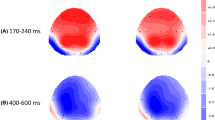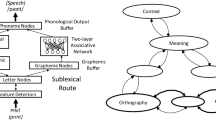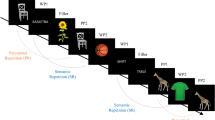Abstract
Most studies of semantic processing address changes in the late (300–800 msec) components of evoked potentials. However, recent years have seen the appearance of data showing that humans can perceive the sense of stimuli presented to them in significantly shorter periods of time. We report here studies of the mechanism of semantic analysis of written abstract and concrete words in four series of experiments: 1) reading of words on a monitor screen; 2) simple classification of all presented words into the categories “abstract” and “concrete;” 3) complex, i.e., selective classification of words written only in a specified color with a prompt as to which color would be used for the word; 4) complex classification of words of only a specified color without a prior prompt. Early (40–100 msec) differences in evoked brain potentials were seen on comparison of responses to abstract and concrete words, predominantly in the frontal areas in the case of simple reading of words and in the more dorsal areas in the case of tasks with simple classification. All cases of explicit classification of words were characterized by differences in late (450–700 msec) components in the left frontal zone. The results indicate the existence of two semantic systems: a rapid, implicit system associated with activation of the right frontal area, and a slow, explicit system of word classification which is predominantly associated with activity in the left frontal area. The relationship between the two systems is to a certain extent reciprocal: the rapid system can by inhibited by introduction of a word classification task.
Similar content being viewed by others
References
J. R. Binder, C. F. Westbury, K. A. McKiernan, E. T. Possing, and D. A. Medler, “Distinct brain systems for processing concrete and abstract concepts,” J. Cogn. Neurosci., 17, 1–13 (2005).
S. Bookheimer, “Functional MRI of language: new approaches to understanding the cortical organization of semantic processing,” Ann. Rev. Neurosci., 25, 151–188 (2002).
P. A. Carpenter and M. Daneman, “Lexical retrieval and error recovery in reading: a model based on eye fixations,” J. Verb. Learn. Verb. Behav., 20, 137–164 (1981).
M. Daneman and E. Reingold, “What eye fixations tell us about phonological recoding during reading,” Can. J. Exptl. Psychol., 47, 153–178 (1993).
A. D. Friederici, “Event-related brain potential studies in language,” Curr. Neurol. Neurosci. Rep., 4, 466–470 (2004).
P. J. Holcomb, J. Kounious, J. E. Anderson, and W. C. West, “Dual-coding, context-availability, and concreteness effects in sentence comprehension: an electrophysiological investigation,” J. Exptl. Psychol. Learn. Mem. Cogn., 25, 721–742 (1999).
A. M. Ivanitsky, A. R. Nicolaev, and G. A. Ivanitsky, “Cortical connectivity during word association search,” Int. J. Psychophysiol., 42, 35–53 (2001).
F. Jessen, R. Heun, M. Erb, D. Granath, U. Klose, A. Papassotiropoulos, and W. Grodd, “The concreteness effect: evidence for dual coding and context availability theory,” Brain Lang., 74, 103–112 (2000).
T. Koenig, K. Kochi, and D. Lehmann, “Event-related electric microstates of the brain differ between words with visual and abstract meaning,” EEG Clin. Neurophysiol., 106, 535–546 (1998).
T. Koenig and D. Lehmann, “Microstates in language-related brain potential maps show noun-verb differences,” Brain Lang., 53, 169–182 (1996).
M. Martin-Loeches, J. Hinojosa, C. Fernandez-Frias, and F. Rubia, “Functional differences in the semantic processing of concrete and abstract words,” Neuropsychologia, 39, 1086–1096 (2001).
C. M. Michel, M. Seeck, and M. M. Murray, “The speed of visual cognition,” Adv. Clin. Neurophysiol., 57, 613–623 (2004).
A. R. Nicolaev, G. A. Ivanitsky, and A. M. Ivanitsky, “Studies of cortical interactions over short periods of time during the search for verbal associations,” Neurosci. Behav. Physiol., 31, 119–132 (2001).
H. Nottono, M. Suehiro, and T. Mori, “Word imageability and N400 in an incidental memory paradigm,” Int. J. Psychophysiol., 44, 219–229 (2002).
S. Ortigue, C. M. Michem. M. M. Murray, C. Mohr, S. Carbonnel, and T. Landis, “Electrical neuroimaging reveals early generator modulation to emotional words,” Neuroimage, 21, 1242–1251 (2004).
A. Paivio, Imagery and Verbal Processes, Holt, Rinehart, and Winston (eds.), New York (1971).
F. Pulvermuller, R. Assadollahi, and T. Elbert, “Neuromagnetic evidence for early semantic access in word recognition,” Eur. J. Neurosci., 13, 201–205 (2001).
G. S. Rubin and K. Turano, “Reading without saccadic eye movements,” Vision Res., 32, 895–902 (1992).
M. Ruz, E. Madrid, J. Lupianez, and P. Tudela, “High density ERP indices of conscious and unconscious semantic priming,” Cogn. Brain Res., 17, 719–731 (2003).
P. J. Schwanenflugel, C. Lakin, and W.-M. Luh, “Context availability and the recall of abstract and concrete words,” Mem. Cognit., 20, 96–104 (1992).
S. C. Sereno and K. Rayner, “Measuring word recognition in reading: eye movements and event-related potentials,” Trends Cogn. Sci., 7, 489–493 (2003).
L. Silvert, S. Delplanque, H. Bouwalerh, C. Verpoort, and H. Sequeira, “Autonomic responding to aversive words without conscious valence discrimination,” Int. J. Psychophysiol., 53, 135–145 (2004).
W. Skrandies, “Evoked potential correlates of semantic meaning — a brain mapping study,” Cogn. Brain Res., 6, 173–183 (1998).
W. C. West and P. J. Holcomb, “Imaginal, semantic, and surface-level processing of concrete and abstract words: an electrophysiological investigation,” J. Cogn. Neurosci., 12, 1024–1037 (2000).
M. S. Worden and J. J. Foxe, “The dynamics of the spread of selective visual attention,” Proc. Natl. Acad. Sci. USA, 100, 11933–11935 (2003).
Author information
Authors and Affiliations
Corresponding author
Additional information
__________
Translated from Zhurnal Vysshei Nervnoi Deyatel'nosti imeni I. P. Pavlova, Vol. 57, No. 5, pp. 566–575, September–October, 2007.
Rights and permissions
About this article
Cite this article
Il’yuchenok, I.R., Sysoeva, O.V. & Ivanitskii, A.M. Two semantic systems in the brain for rapid and slow differentiation of abstract and concrete words. Neurosci Behav Physi 38, 963–970 (2008). https://doi.org/10.1007/s11055-008-9083-5
Received:
Accepted:
Published:
Issue Date:
DOI: https://doi.org/10.1007/s11055-008-9083-5




